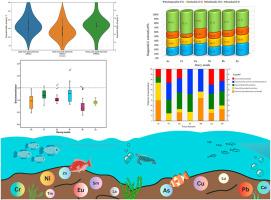伊朗西北部萨尔达什特小扎布河沉积物中稀土及微量元素来源及富集评价
IF 3.4
3区 地球科学
Q1 GEOCHEMISTRY & GEOPHYSICS
引用次数: 0
摘要
沉积物中稀土和微量元素的地球化学特征有助于了解它们的起源以及人类活动对河流生态系统的潜在影响。本研究考察了西阿塞拜疆省(伊朗)小扎布河沉积物中重金属和稀土元素的浓度、生物利用度和来源,结合了分析技术(总浓度和选择性提取)和数据分析(富集因子、稀土异常、高级统计分析)。As、Cr、Cu、Fe、Ni、Pb和Zn的平均浓度分别为9.11、163.71、37.47、36,684.3、99.41、8.94和85.76 mg/kg,其中近一半存在于残留相,因此不具有生物利用性。正矩阵分解(PMF)模型确定了反映半自然、城市、农业和工业来源的四个因素,以及城市-农业共同来源的重金属。Cr和Ni在大多数采样站(即使在上游样本)的浓度高于指标值。总REE浓度范围为88.6 ~ 173.5 mg/kg,平均127.6 mg/kg, Eu呈正异常。与欧洲页岩和大陆地壳标准的对比分析表明,稀土元素的成因为陆相。这些发现表明,小扎布河周围的城市和农业活动并没有明显破坏其自然生态系统。然而,它是由不同的国家共享的,容易发生跨境污染。本文章由计算机程序翻译,如有差异,请以英文原文为准。

Evaluating the sources and enrichment of rare earth and trace elements in sediment of Little Zab River, Sardasht, Northwest Iran
The geochemistry of rare earth and trace elements in sediments provides insights into their origin and the potential effects of human activity on the river ecosystem. This study examined the concentration, bioavailability, and sources of heavy metals and rare earth elements in sediments of the Little Zab River in West Azerbaijan province (Iran), using a combination of analytical techniques (total concentration and selective extractions) and data analysis (enrichment factors, rare earth anomalies, advanced statistical analysis). Average concentrations of As, Cr, Cu, Fe, Ni, Pb, and Zn were 9.11, 163.71, 37.47, 36,684.3, 99.41, 8.94, and 85.76 mg/kg, respectively, with nearly half existing in the residual phase, therefore non-bioavailable. The Positive Matrix Factorization (PMF) model identified four factors reflecting semi-natural, urban, agricultural, and industrial origins, beside a shared urban-agricultural source for heavy metals. Cr and Ni showed higher concentrations than guideline values in most sampling stations (even in the upstream sample). Total REE concentrations ranged from 88.6 to 173.5 mg/kg, averaging 127.6 mg/kg, with a positive Eu anomaly. Correlation analysis and comparisons to European shale and continental crust standards suggested a terrestrial origin for the REEs. These findings indicate that urban and agricultural activities around the Little Zab River have not significantly disrupted its natural ecosystem. However, it is shared between different countries and is prone to transboundary pollution.
求助全文
通过发布文献求助,成功后即可免费获取论文全文。
去求助
来源期刊

Applied Geochemistry
地学-地球化学与地球物理
CiteScore
6.10
自引率
8.80%
发文量
272
审稿时长
65 days
期刊介绍:
Applied Geochemistry is an international journal devoted to publication of original research papers, rapid research communications and selected review papers in geochemistry and urban geochemistry which have some practical application to an aspect of human endeavour, such as the preservation of the environment, health, waste disposal and the search for resources. Papers on applications of inorganic, organic and isotope geochemistry and geochemical processes are therefore welcome provided they meet the main criterion. Spatial and temporal monitoring case studies are only of interest to our international readership if they present new ideas of broad application.
Topics covered include: (1) Environmental geochemistry (including natural and anthropogenic aspects, and protection and remediation strategies); (2) Hydrogeochemistry (surface and groundwater); (3) Medical (urban) geochemistry; (4) The search for energy resources (in particular unconventional oil and gas or emerging metal resources); (5) Energy exploitation (in particular geothermal energy and CCS); (6) Upgrading of energy and mineral resources where there is a direct geochemical application; and (7) Waste disposal, including nuclear waste disposal.
 求助内容:
求助内容: 应助结果提醒方式:
应助结果提醒方式:


